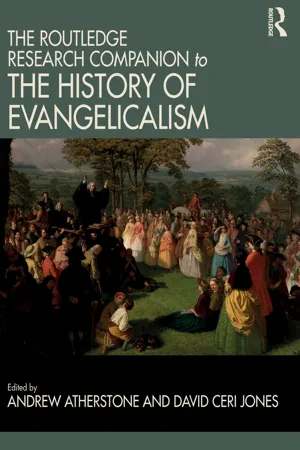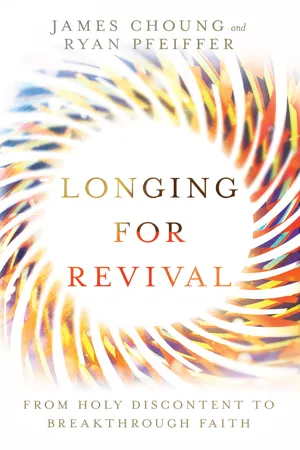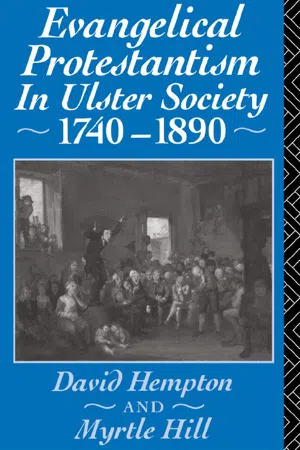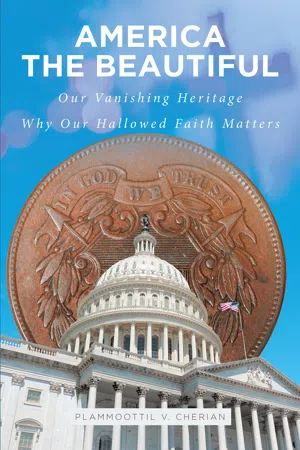History
Religious Revival
A religious revival refers to a period of renewed interest and enthusiasm for religious beliefs and practices within a particular community or society. These revivals often involve large-scale gatherings, emotional religious experiences, and a heightened sense of spiritual fervor. They can lead to significant social and cultural changes, as well as the revitalization of religious institutions and traditions.
Written by Perlego with AI-assistance
Related key terms
Related key terms
1 of 4
Related key terms
1 of 3
9 Key excerpts on "Religious Revival"
- Andrew Atherstone, David Ceri Jones(Authors)
- 2018(Publication Date)
- Routledge(Publisher)
5 Evangelicals, Revival and RevivalismMichael J. McClymondWriters use the terms ‘revival’ and/or ‘revivalism’ to denote a period of renewed religious experience, fervour or devotion. Michael Watts referred to the British evangelical revival of the eighteenth and early nineteenth centuries as ‘an attempt to return, after the spiritual lethargy of the late seventeenth century, to the religious fervour of an earlier age’.1 Webster’s Third New International Dictionary defines the term ‘revival’ as ‘a period of religious awakening: renewed interest in religion with ‘meetings often characterized by emotional excitement’.2 The concept and experience of Christian revival are not unique to English-speaking Protestantism. Foreign equivalents for the English term ‘revival’ include: Erweckung (German), réveil (French), avivamiento (Spanish), fen xing (Chinese), and bu hung (Korean). To call a religious gathering a ‘revival’ is to suggest that an intensification of experience has occurred. A gathered multitude does not as such constitute a ‘revival’. What distinguishes a ‘revival’ is a deepening of religious feeling and expression. ‘Revivals’ are corporate, experiential events. In ‘revival’ there is often a spiritual contagion – an infectious influence transmitted by proximity – causing one person’s spiritual experiences to spill over to others. The term ‘renewal’ is not as well defined as revival, and yet it suggests a return of zeal or vitality to a group of Christian believers who have declined in their devotion.Since the early eighteenth century, reports of Christian revivals from differing geographic regions and cultural groups have shown common themes. Participants in revivals speak of their vivid sense of spiritual things, great joy and faith, deep sorrow over sin, passionate desire to evangelize others, and heightened feelings of love for God and fellow humanity. In times of revival, people often crowd into available buildings for religious services, filling them beyond capacity. Services may last from morning until midnight. News of a revival usually travels rapidly, and sometimes the reports of revival – in person, print or broadcast media – touch off new revivals in distant localities. During a revival, clergy and other Christian workers may receive many requests for their services. Sometimes people openly confess their sins in public settings. Another mark of revivals is generosity – individuals willing to give their time, money or resources to support the work of the revival. Revivals are typically controversial, drawing fierce opposition as well as loyal support. Often there are unusual bodily manifestations in revivals, such as falling down, rolling on the ground, involuntary muscle movements, laughing, shouting and spiritual dancing. Another common feature in revivals is the occurrence of so-called signs and wonders, such as the healing of the sick, prophecies, visions or dreams revealing secret knowledge, deliverance or exorcism from the power of Satan and the demonic, and speaking in tongues.- eBook - ePub
Longing for Revival
From Holy Discontent to Breakthrough Faith
- James Choung, Ryan Pfeiffer(Authors)
- 2020(Publication Date)
- IVP(Publisher)
1 trace back to biblical metaphors for the infusion of spiritual life in Christian experience by the Holy Spirit. Usually they are used synonymously.”So what is revival?The first set of definitions we found is clustered around personal or corporate reinvigoration of our spiritual experience. Charles Finney, a minister and leader in the Second Great Awakening, defined revival as “a renewed conviction2 of sin and repentance, followed by an intense desire to live in obedience to God.” Mid-twentieth-century British pastor Martyn Lloyd-Jones described it as “a period of unusual blessing3 and activity in the life of the Christian Church.”What they all are saying in so many words is this: in revivals, faith becomes “white-hot.”4 And although we liked these definitions as far as they went, we yearned to include more specifics about how revival would be expressed and how it might spill over to those who don’t identify as Christian.Others add more specifics to their definitions. In his book, Revivals: Their Laws and Leaders, James Burns highlights the amount of people involved: “Large numbers of persons5 who have been dead or indifferent to spiritual realities then become intensely awakened to them.” Pastor Tim Keller offered one along the same lines: “A season in which6 a whole body of believers experience gospel renewal together.” Lovelace adds a missional element: “Broad-scale movements7 of the Holy Spirit’s work in renewing spiritual vitality in the church and in fostering its expansion in mission and evangelism.” Author Mark Shaw adds a societal effect to his definition: “Global revivals are charismatic people movements8 that transform their world by translating Christian truth and transferring power.”We liked these additions as well but wanted to see them come together in a single definition. But I’d like to pause here and ask, Whatever misgivings you might have about the word revival - eBook - ePub
Studies in World Christianity
The Rise of Indian-Initiated Churches
- Paul Joshua, Joel A. Carpenter(Authors)
- 2022(Publication Date)
- Baylor University Press(Publisher)
Edwin Orr, the prominent revivalist, historian, and theologian of modern revivals, “Christian revival” is “the revitalizing of a body of Christian believers.” 7 It is a specifically Christian phenomenon and, generally speaking, “means the coming of life to something that has already possessed life.” 8 For example, a tree revives when it sprouts leaves in spring after a long winter. While it is an intra-Christian process, Orr emphasizes that revival is not an end in itself, for it necessarily leads to Christian engagement in the wider world, via evangelism and social reform. A positive reception of such activity and a quickening of religious interest among the general population is then called an “awakening,” a “stirring of interest in the Christian faith in the related community of nominal Christians or unbelievers.” 9 Orr also stresses that while revivals rely on human agency, none of these effects are possible without the involvement of the Holy Spirit to quicken people’s sense of God’s presence and convict them of their need to be in right relationship to God. Revival, mission, and awakening, Orr insists, are all authored by the Holy Spirit. 10 Perhaps because this work of the Holy Spirit is erroneously thought of exclusively in terms of one’s personal relationship to God, Orr elucidates the working of the Spirit via human agency to effect significant societal impact. He cited the nineteenth-century European and North American revivals and their commitments to world mission, social reform, and humanitarian concern. 11 While affirming those observations, Bishop Appasamy deepened the theological analysis of revival. First, he emphasized the role of “spiritual pain that often accompanies revival.” He explained that “sinners convicted by the Holy Spirit often suffer agony - eBook - ePub
A Stone of Hope
Prophetic Religion and the Death of Jim Crow
- David L. Chappell(Author)
- 2009(Publication Date)
- The University of North Carolina Press(Publisher)
The movement’s habit of drawing on revivalist traditions, and its injection of powerful religious emotions into the public discussion that shaped civil rights legislation in the mid-1960s, raise important questions. One is whether our peculiar modern habit of separating religion from politics is entirely realistic. It is now customary for historians and sociologists to point out the great political effects of revivals in the past. So many scholars are driven by a revulsion with oppression that a major trend in contemporary scholarship—perhaps a unifying theme in the otherwise factious humanities and social sciences—focuses on how oppression succeeds and how resistance to oppression sometimes succeeds against the odds. The political decline of the American Left and the fall of organized socialism in Russia and much of Europe has led to a renewed interest in the role that religion might play in defeating what secular movements have failed to defeat. Scholars of Religious Revivals have made significant findings along these lines.Much sociological and historical work explains how revivals often serve to justify social changes to deeply conservative masses of people. Sometimes the changes benefit those masses, often they harm them, but in either case the changes require unaccustomed ways of thinking. Revivals provide and reinforce these new ways with frequent repetition and memorable imagery. In the revivals that are conventionally recognized as such, the political and social results were generally indirect and unintended. But the civil rights preachers’ making such results their explicit goal is no more significant than other changes in doctrine from one Awakening to the next. The massive religious upheaval in the 1740s in New England reaffirmed predestination, for example, and the upheaval of the early nineteenth century repudiated it. But that colossal theological difference does not stop most of us from referring to the two upheavals as the First and Second Great Awakenings. - David Hampton, Myrtle Hull(Authors)
- 2004(Publication Date)
- Routledge(Publisher)
PART FOUR From Religious Revival to provincial identity
Passage contains an image
[8] Ulster awakened: the 1859 revival
And it shall come to pass in the last days, saith God, I will pour out of my Spirit upon all flesh: and your sons and your daughters shall prophesy, and your young men shall see visions, and your old men shall dream dreams. (Acts 2:17)And the Lord added to the church daily such as should be saved. (Acts 2:47)The phenomenon of Religious Revival, now that it scarcely troubles the Protestant churches of the northern hemisphere, has become an avid subject of inquiry for historians, sociologists and social anthropologists. Such intense study has thankfully improved our understanding of what are bewilderingly complex events. In the past social historians had a tendency to reduce explanations of revival to economic depression, political excitement, or chancy notions of societal modernization. Ecclesiastical historians responded by emphasizing the importance of theology, personal religious experience and the centrality of revivalistic preachers. Such explanations no doubt have their place, but they often fail to describe or interpret the process of Religious Revival in a way that would be recognizable to those who were revived. While admitting that human beings are not often the best judges of what is happening around them, it is surely churlish not to pay some attention to the human emotions, expectancy and experiences of those who engaged in the community rituals of Religious Revivalism. More recent work, by suggesting that Religious Revivals have an internal dynamic of their own, and by paying more attention to the laity and their religious experiences, has shed new light on old problems of explaining outbreaks of dramatic religious enthusiasm.1 In particular, a number of studies of transatlantic revivals have drawn attention to the way in which vibrant community-based rituals, such as the Methodist love-feast and the Presbyterian communion season, have acted as focal points of intense emotion.2- eBook - ePub
The Rise of the Global South
The Decline of Western Christendom and the Rise of Majority World Christianity
- Kim(Author)
- 2012(Publication Date)
- Wipf and Stock(Publisher)
260 Spiritual versus RationalThe “Protestant crisis” of secularism can be traced back to the 1730s. Concurrently, revival movements were being set in motion and international revival connections were forming even in the midst of religious and social tides of anti-Protestant sentiment. Political upheavals in continental Europe stemming from the expansion of Protestant territories, especially in Catholic countries, caused British and American authorities to pay close attention to several renewal and revival movements. In the early eighteenth century, just before the 1730s, some political positions held by Protestants did return to Catholicism. In one example cited by Crawford, “the Reformed house in the Palatinate had died out and had been succeeded by a Catholic branch.”261 But, on balance, the effects of revivals and awakenings in the transatlantic region were quite remarkable. As a result of the revival, Edwin Err reports, between 1740 and 1800, a momentous church growth took shape among non-conformist churches. Churches went from 27 to an astounding 926 and temporary chapels also sprang up from 506 to 3,491.262The eighteenth century revivals carried widespread ramifications throughout Western Europe. Individuals from all denominations were transformed by personal confession in Christ, commitment to God, and reliance on the Holy Spirit. These experiences motivated overseas missionary work and related efforts to share the gospel so that others might also have the joy of salvation. Those touched by the revival worked to eradicate slavery, reform child labor laws, and fight discrimination against those at the lower end of the social ladder. The expanding revival drew public attention for its spiritual vigor and for the involvement of laypeople. The revivals’ domino effect created a glowing optimism and caused the decline of conventional social authorities, the rigid Anglican hierarchy, and the values of individualism and secularization.263 - eBook - ePub
Islam in Perspective
A Guide to Islamic Society, Politics and Law
- Patrick Bannerman(Author)
- 2013(Publication Date)
- Routledge(Publisher)
It is more helpful to define the revival more generally, as an increased consciousness of and reaffirmation of belief in the values and ethic of Islam in all aspects of life, and a more assertive and active expression of that consciousness and reaffirmation in most parts of the Muslim world. In particular, the re-emergence of Islam as the preferred framework for political and social activism suggests that the process has included a higher profile for the political and social sub-systems defined in Chapter 1. However, this must be qualified in three important ways. In the first place, although Islam has never, as suggested already, been abandoned as a system of belief, there has undoubtedly been a genuine reaffirmation of faith, an individual religious renewal, particularly among the more sophisticated and better-educated sections of society, many of whose members had earlier neglected or even rejected Islam as a political, social, and religious norm — those frequently described as ‘secularists’. As one authority observes: Educated people relaxed their observance of the Ramadhan fast, ate pork, rarely if ever prayed, and rarely entered a mosque. They had largely turned their back on Islam as a dominating force in their life, although remaining steadfast in their self-image as Muslims. As one observer put it, they were cultural Muslims but not pious believers. 7 Second, although it is tempting to seek to identify a unified, transnational leadership and movement, the ferment among Muslims and the current resurgence of Islamic fundamentalism, while widespread, do not appear to be the result of a universal Muslim revival movement, nor do they proceed from a single centre - eBook - ePub
America The Beautiful
Our Vanishing Heritage; Why Our Hallowed Faith Matters
- Plammoottil V. Cherian(Author)
- 2020(Publication Date)
- Covenant Books, Inc.(Publisher)
The United States of America and the United Kingdom are two nations grown to strength and fame because of the spiritual awakening of the eighteenth and nineteenth centuries. Of the nine colonial colleges in America, six were born as the result of spiritual awakenings. American and British awakenings led to the worldwide evangelical awakening, which spread the Gospel around the world throughout the nineteenth century. In 1800, Christians were concentrated in Europe and North America; by 1900 many Christians were in China, India, and Africa. India had a Christian origin as early as AD 52 when Apostle Thomas took the Gospel to the Malabar Coast and founded seven churches in the state now known as Kerala. However, with the help of British and American missionaries, the Gospel message was enforced, and many have learned the Gospel, and yet India’s Christian population is only 2.5% of the 1.5 billion people in India, according to the latest census data.In the Bible from Genesis, Exodus, Joshua, Samuels, Kings, Chronicles, minor prophets’ gospels, and the book of Acts, one can see great revivals. Christian revivals means a spiritual reawakening from a slumbering state of backsliding in faith to an awareness for improved dedication, commitment, and devotion to the Almighty God by his people. Revival is needed for individuals, families, leaders of a nation and the nation itself. Old Testament kings like Asa, Jehoshaphat, Hezekiah, and Josiah and in the New Testament Jesus Christ, Peter, Stephen, and Apostle Paul were great revivalists. America had great Christian revival in the past, which increased enthusiasm and awareness for guidance and dependence on Lord God. Historians and theologians identify three or four great revivals that emphasized salvation by Jesus Christ on the cross of Calvary, where God came down from heaven to meet humanity known by the name Homo sapiens - eBook - ePub
The Disruption of Evangelicalism
The Age Of Torrey, Mott, Mcpherson And Hammond
- Geoffrey R. Treloar(Author)
- 2016(Publication Date)
- IVP(Publisher)
2. REVIVAL, REVIVALISM AND MISSIONSFrom the beginning of the history of the movement, life as an evangelical was thought to begin with the conversion of the individual, that point of decision at which the offer of salvation by faith in Christ was accepted with all of its consequences.1 At once the product and the means of the awakenings of the 1730s and 1740s, this understanding gave rise among evangelicals to preaching for repentance as a standard practice and the perennial hope of further revival, the conversion of large numbers of people in a community at more or less the same time. Understood initially in the eighteenth century as ‘a surprising work of God’, the result of divine agency, early in the nineteenth century conversion was reframed by Charles G. Finney as ‘a work of man’, a shift that resulted in revivalism, the organized attempt to bring about conversion on a large scale by human effort. In a further development in the final quarter of the nineteenth century, the techniques of revivalism were adjusted to the conditions of modern cities by D. L. Moody and his many imitators throughout the English-speaking world. Simultaneously with these developments, the modern missionary movement moved towards the point of commitment encapsulated in the controversial slogan ‘the evangelization of the world in this generation’. However understood, action to bring about conversion at home and abroad was not only a hallmark of fin de siècle evangelicalism but stamped it at the time as an intensely proselytizing religion.Although still generally accepted as the principal means by which people were brought into the movement, around 1900 conversion was much discussed by evangelicals. On the one hand, there was a deep and pervasive concern that preaching for conversion had fallen into a lull, the number of conversions was declining, and church attendance was falling. The need in many minds was for an intensification of conversionist activism in the form of ‘a great forward movement’ with a sharp spiritual and evangelistic focus, both locally and globally. Behind this call, as ever, was the revival hope. On the other hand, the reality and nature of conversion came under the disruptive scrutiny of ‘the new knowledge’, principally in the nascent psychology of religion that presented conversion as a natural process subject to empirical observation, rational analysis and improvement.2
Index pages curate the most relevant extracts from our library of academic textbooks. They’ve been created using an in-house natural language model (NLM), each adding context and meaning to key research topics.
Explore more topic indexes
Explore more topic indexes
1 of 6
Explore more topic indexes
1 of 4








